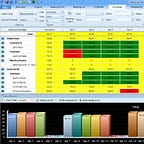Resource Management Software — What Makes it so Crucial?
Resource Management has become one of the daunting challenges for organizations.
Attracting, developing and maintaining an effective workforce is an area of top priority in the contemporary business environment. According to Marcic and Daft (2010), employees give a company its primary source of competitive advantage. They are the indispensable pillars of a company in its goal of achieving a sustained competitive success. However, managing the employees poses a challenge to many managers.
For instance, companies are keen on establishing multiple locations globally. While this is definitely an advantage, it comes with challenges of managing many employees, from different countries, different cultural preferences, and even from distant locations. Similarly, a company may have an overwhelming number of employees, all based in the same location.
Managers face the difficulty of recruitment, training and development, performance appraisal, and rewarding. In addition, managers have to address industrial relations issues, succession planning, diversity, and inclusion. It is in the best interest of the company to lower employee turnover in order to remain competitive in the current global work environment. Marcic and Daft (2010), assert that managers have to place employees in the right roles and place them in the right positions where they are most effective.
Poor management of employees increases employee’s turnover. Consequently, companies bear the heavy costs of recruitment and hiring of new employees. In addition, poor management systems and practices deflate the morale of the workforce. Disgruntled and mishandled employees deemphasize on optimal performance efforts and work for survival.
Moreover, a resentful and angry employee may decide to leave the work altogether. Poor corporate strategies regarding the employees may lead to role conflict in the workplace. In addition, managers in such situations do not give credit to the right person and may blame an employee for mistakes he or she has not committed. Moreover, managers may disrespect employee’s privacy and may also not be keen on the right compensation for each employee.
In a worst case scenario, companies have had ghost workers whereby an employee is in the payroll and does not report to work. According to Fina (2009), some employees feel alienated in the workplace and this may affect their performance. For instance, some employees may shun team work in favor of more focused individual effort and contribution.
A resource management software ( Like eResource Scheduler ) comes in handy to help a manager have an easier time in the management of employees. To start with the software ensures that a company has the capacity to plan, organize, and manage resource pools and put in place resource requirements forecasts. It includes tools of estimation, planning, scheduling, cost control, resource allocation, and documentation. It can help manage the staff workload and carry out a periodic update of employees’ schedule.
In addition, there is a reporting component that can help a manager monitor the teams. Moreover, a resource management software can show what each person is working on and show the availability of a certain employee. It can identify the right person for a job depending on the client’s suitability. Furthermore, it can also send alerts if an individual or group is overloaded.
A resource planning software can be used by a company to collect, store, manage, and interpret data. This makes the employees accountable for their actions since their business duties are monitored. The integrated applications may help in product planning, cost, and development, service delivery or manufacturing, sales and marketing, inventory management, shipping, and payment. Its greatest benefit is that myriad business processes can be carried out with less time and less cost. It can give a chronological history of every transaction that is carried out by each employee.
It can match purchasing orders and do revenue tracking. It brings transparency and legitimacy to statistical data. It provides a comprehensive view of information and protects sensitive data through multiple security systems.
In conclusion, resource management software and resource planning software supports a variety of business functions. They are of great help in managing the human capital of a business entity. As business entities expand, demand for employees increases. Consequently, managing the employees becomes more difficult. Overall, the software helps a company to save time and resources and also manage the employees effectively through automating resource management.
